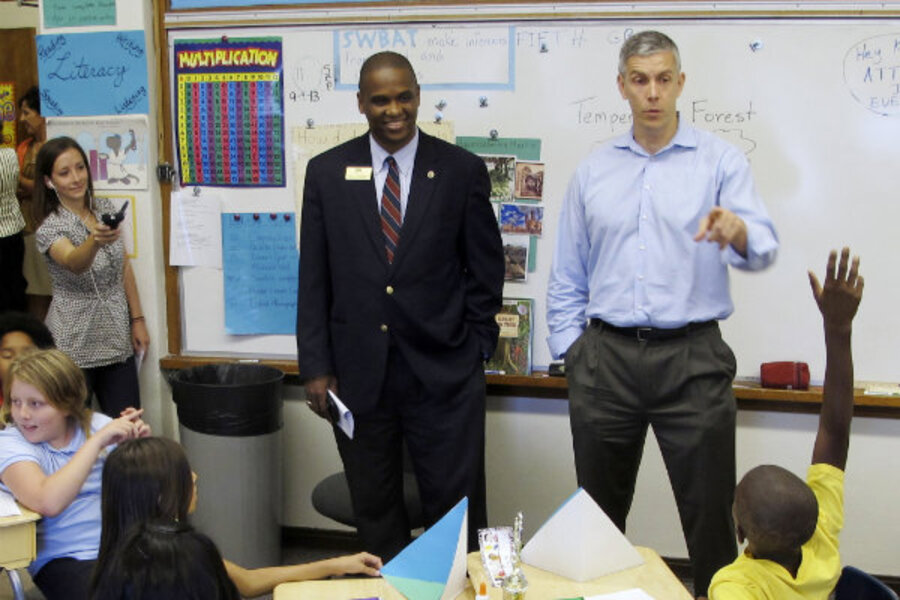Arne Duncan: Why I am optimistic about education in America
Loading...
| Washington
Earlier this month, my colleagues and I wrapped up a five-day, 1,100-mile back-to-school bus tour of the Southwest. It was exciting, occasionally exhausting, and often exhilarating. But most of all, it was enlightening.
From New Mexico to Texas, from Arizona to California, we saw firsthand how courageous educators, committed parents, and caring communities can work together to tackle tough educational challenges.
Along the way, we saw states that failed to provide sufficient early-learning opportunities, school districts that lacked access to high-speed broadband Internet service, and families that struggled to pay for college. In one border town, some elementary school students had never held a pencil or book until they started school.
Yet for every challenge, I also saw communities, schools, and visionary leaders pulling together to meet those challenges.
In Arizona, the state is funding preschool in part through tobacco taxes. It’s an innovative idea. In fact, it is the funding model for President Obama’s historic Preschool for All proposal, which would use increased cigarette taxes to extend high-quality preschool to all 4-year-olds from low- and moderate-income families.
In rural Socorro, N.M., the school district solved the problem of broadband Internet access by partnering with the New Mexico Institute of Mining and Technology to install a cell tower on top of a local mountain to transmit wireless Internet to all its schools.
And Arizona State University has taken a series of steps to ensure that ASU remains affordable for middle-class students – from first-generation collegegoers to low-income Hispanic students.
As the school year gets under way, I am optimistic about our capacity to elevate and strengthen education in America – despite serious challenges.
I am optimistic because, during the past 4-1/2 years, and on the bus tour, I saw great principals and teachers; courageous leaders from the business, faith, and nonprofit sectors; engaged parents; and whole communities joining forces to provide all students with a world-class education.
I am optimistic because I have seen students whose grit and passion for getting an education persist under even trying circumstances – students such as Abagail Smith in Yuma, Ariz., who, as a child of military parents, has attended 10 different schools as her family has endured deployments and moved numerous times to serve this nation. Because of her love of learning, she plans to become a special-education teacher.
And finally, I am optimistic because I see encouraging signs of progress nationwide.
During the Obama administration’s first term, the high school graduation rate rose to its highest level in three decades and is now at 78 percent. And since 2008, the number of teens trapped in high school “dropout factories” – schools where fewer than 60 percent of ninth-graders graduate four years later – has dropped by nearly 700,000 students.
This progress is happening even as states raise standards and expectations for children, instead of lowering them. In an educational sea change, 46 states, plus the District of Columbia, have voluntarily adopted the rigorous, state-crafted Common Core State Standards.
Across the Southwest we saw the same pattern repeated. Successful solutions and effective innovations inevitably originated at the local level, not in Washington. They entailed setting high standards and expectations for students, coupled with real support.
And while successful innovations originate at the local level, they flourish in partnerships with nonprofits, community and faith-based organizations, and the state and federal government. Providing a world-class education is a shared responsibility – no one gets a pass.
A case in point: Castle Park Middle School in Chula Vista, Calif. Three years ago, Castle Park had the worst attendance record in the school district. Some days, 75 kids would miss school. More than half the students had no plans to go to college. Student achievement was abysmal.
But with the help of a five-year, $28 million Promise Neighborhood grant from the US Department of Education, the school and community are undergoing a remarkable turnaround.
The area’s nonprofit South Bay Community Services, along with 28 local partners, is providing early learning, after-school support, increased access to health and wellness services, counseling and social supports, and workforce development services for children and families in the surrounding neighborhood.
A 100-hour-plus training program for parents and local residents has helped parents become more engaged and invested in their children’s academic success.
At the school, Castle Park implemented a rigorous turnaround program and required students to complete all missing homework assignments before they could go home at the end of the school day.
Test scores have risen by nearly double-digits in almost every subject at Castle Park – and the school has the best attendance record in the district, with almost 100 percent of kids in class every day.
So, from cradle to career, from countryside to city-side, Americans are working hard to receive the world-class education they need to succeed in today’s knowledge-based, globally competitive economy.
W.E.B. DuBois said that “of all the civil rights for which the world has struggled and fought for 5,000 years, the right to learn is undoubtedly the most fundamental.”
I agree – and my wish for all students is that they enjoy the right to learn in the coming year.
Arne Duncan is the US secretary of Education.







